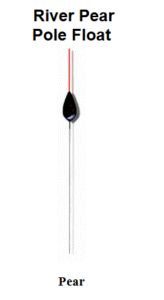
🪶 River Pole Float (Pear Shape)
Although the pear-shaped float is most commonly associated with still-water fishing, it can also be extremely effective on running water when used correctly. Its tapered, aerodynamic design allows it to cut through the water with minimal resistance, making it particularly sensitive and responsive to any movement or bite below the float.
Because this float has a lightweight capacity, it performs best when overshotted and held back with the pole against the flow. This allows the angler to counterbalance the tow and control the speed of the bait through the swim with remarkable precision. Even the slightest pressure on the line can register as a bite, so maintaining constant line contact is essential. If the line tension is released, the float will simply sink — meaning balance and control are everything.
🏆 Proven in World Championship Conditions
I first developed this method in 1990, on the River Drava in Yugoslavia, during the World Championships. The river was around 18 feet deep and pushing through hard. By easing the pear float through the swim slowly and steadily, I was able to catch when others struggled.
The fish we targeted were sterlet (often called “cigar fish”), small sturgeon-like fish that hugged the bottom. This presentation came from a technique I learned and adapted from my French international friends, who went on to win the team event using a similar method.
I managed fourth place in my section on Day One, just ahead of the famous Mr. “Groundbait” Van Den Eynde on the next peg. A bit of bad luck on the second day cost me a higher finish, but the method itself proved almost unbeatable — and Bob Nudd went on to win his first World Championship with the same approach.
🪝 Shotting and Presentation Tips
-
Use an Olivette positioned about 18 inches from the hook.
-
Add a string of shots on the hook length, gradually reducing in size.
-
Fish the rig slightly over depth, adding more weight if necessary to match the flow pressure.
-
Follow the float down the swim to maintain line tension and control the pace.
-
Expect some false bites — if the float dips, gently lift to set the hook. If there’s no fish, lower it back into position and let it trot through again.
This is a sensitive and precise method, and once mastered, it gives the angler tremendous control over bait presentation in strong flowing water.
Some illustrations found in the book


Click on Links to Pages
-
French Pear Shape
-
Reverse Pear
-
Shoulder Pear (reverse pear)
-
Small Shoulder
-
Long Shoulder
-
Long Body River (Pencil)
-
Oval Body
-
Barrel Body
-
Wine Bottle
-
Round Body
-
Flat Float
-
Dipper
-
AVON HEMP FLOAT
___
📘 Now available in paperback: The Complete Float Manual — over 169 pages of float-fishing techniques, history, and methods.
Click on book cover to order

📘 Download the Complete Float Manual – Instant Access
Bring decades of float-fishing knowledge straight to your screen.
Written by World Champion Clive Branson, The Complete Float Manual is a 167+ page eBook packed with practical techniques, classic float designs, diagrams, and championship-winning methods.
✅ Learn how to use wagglers, stick floats, pole floats and more
✅ Discover the history and evolution of float fishing
✅ Get pro tips and tactics used at the highest level
✅ Ideal for beginners and experienced match anglers alike
💻 Instant Download (PDF) — no waiting, no shipping
💳 Secure checkout with PayPal
👉 Order now and start reading within minutes.
Watch my Vlog: Running water Pole Floats